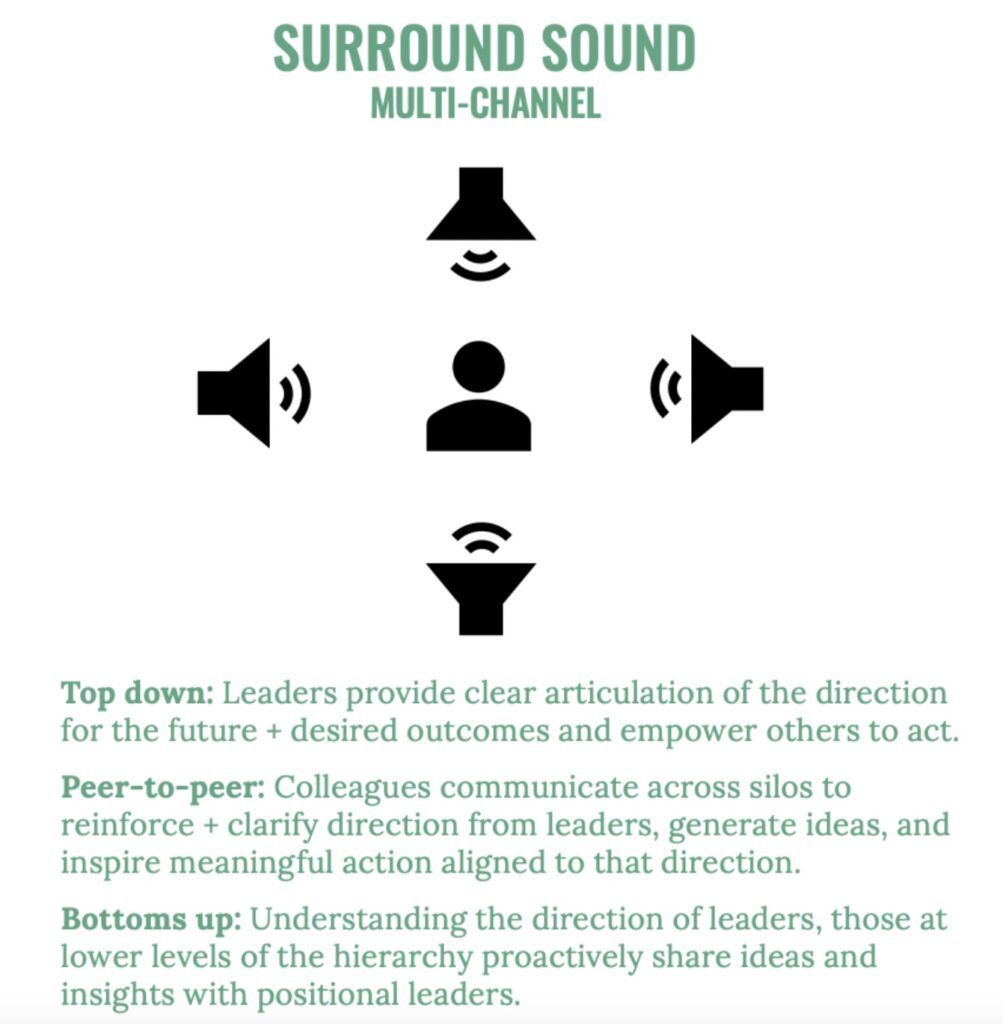


The pace of change has increased dramatically over the last few decades, and we have seen this intensify recently. In just the last three years we have experienced a worldwide pandemic, disruption in global supply chains, war in Ukraine, systemic labor shortages, runaway inflation, rising interest rates, a looming recession, and now a crisis of confidence in the banking system—all this at the same time. It has perhaps never been more important that organizations and their leaders become effective at navigating the increased pace of change and communicating their management strategy. As former General Electric CEO Jack Welch put it, “If the rate of change on the outside [of your organization] exceeds the rate of change on the inside, the end is near.”
Through research, we know much more today about the human brain and why people react to change the way they do. There is a reason why many people say, “I don’t like change,” and it has as much to do with biology as psychology. There is a science to change that leaders should be leveraging in their change management communications approach by moving beyond “burning platforms” and “cascaded” communications to sustained organizational performance and the emerging “surround sound” approach.
Most have probably heard Sir Winston Churchill’s famous quote, “Never let a good crisis go to waste.” Many are also likely familiar with the “burning platform” concept, which has been used in change management for over 30 years. It has been effective in prompting people to react quickly to well communicated threats, resulting in them making immediate, desired behavior change that benefits the organization.
Yet, given the increased pace of change in the world today, there are two challenges emerging with the continued use of the “burning platform” approach
1. Once people are out of range of the perceived threat, they tend to “stop running” and in many cases return to their previous ways of doing things, putting the sustainability of the change at risk.
2. When in “survival” mode, the brain and body are so focused on the perceived threat, people are not able to spot “opportunities” or perhaps even other threats.
We have recently been able to combine intense observational research with methods that are able to map the hardwiring of the brain and body to learn that humans possess something we call the Survive Channel. It has the biological equivalent of a radar system that is constantly on the lookout for threats. When our brain detects what is perceived to be danger, Adrenaline is released into our bodies, increasing heart rate and blood pressure, accelerating breathing to increase oxygen to the blood stream, and releasing blood sugar and fats to prepare us to confront or escape the problem (“fight or flight”). When this happens, our minds tend to focus like a laser on the perceived threat. We use our spiked energy and total focus to attempt to eliminate the hazard. When we are successful and the problem is resolved, the chemicals stop flowing, we calm down, and our body resets to where it was before the “attack.”
Unfortunately, in today’s rapidly changing world, with more threats and opportunities surfacing constantly, it is not at all unusual for people to experience an overheated Survive response which can convert their laser focus into a state of paralysis. Given the increasing pace and magnitude of change we are experiencing today, the challenges posed by a “burning platform” can be quite problematic for organizations from a change management communications perspective.
 The “cascaded” or “waterfall” communications approach has historically proven to be very effective for igniting burning platforms. The theory is quite simple. It involves senior leaders clearly communicating a message to their direct reports who in turn recommunicate that message to the next layer down within the organization in a process which repeats until ultimately reaching everyone at all levels. This approach is commonly used in organizations with a well-established “hierarchy” and more of a “command and control” leadership style. It has the advantage of a consistent message being communicated throughout the organization.
The “cascaded” or “waterfall” communications approach has historically proven to be very effective for igniting burning platforms. The theory is quite simple. It involves senior leaders clearly communicating a message to their direct reports who in turn recommunicate that message to the next layer down within the organization in a process which repeats until ultimately reaching everyone at all levels. This approach is commonly used in organizations with a well-established “hierarchy” and more of a “command and control” leadership style. It has the advantage of a consistent message being communicated throughout the organization.
But because of the increased pace of change, many organizations are realizing the limitations of the traditional hierarchy and are having their employees work across silos in more of a networked fashion. The “cascaded” communication approach is less effective in a more networked organizational structure and hinders rapid adaptation because of the sheer volume of opportunities and threats surfacing continuously. Additionally, when leadership’s message is cascaded like the “telephone game”, there is zero sense of agency with the receiver and this lack of control can also be a Survive trigger.
It is for these reasons that leaders should be turning to the neuroscience behind the opportunity-seeking radar we call the Thrive Channel and tapping into a “surround sound” communications approach.
Thankfully the brain and body have another radar system we call the Thrive Channel, which instead of looking for threats, seeks opportunities. When our brain spots possibilities, a set of chemicals (different than with Survive), like oxytocin and vasopressin are released into our bodies causing our energy level to rise but not spike. Thrive is accompanied by emotions like passion and excitement rather than anxiety or anger. Instead of narrowing, our focus expands as curiosity about the opportunities broadens our field of vision.
 With these positive emotions triggered by the Thrive Channel, we are more open to collaboration, creativity, and innovation. The mind and body search for ways to move toward opportunities. As long as we see evidence that we are making progress, our increased energy can be sustained for a remarkably long period of time without feeling burned out. Given the increased number of threats and opportunities associated with today’s increasing pace of change, energizing people by activating their Thrive Channel can generate greater sustained organizational performance.
With these positive emotions triggered by the Thrive Channel, we are more open to collaboration, creativity, and innovation. The mind and body search for ways to move toward opportunities. As long as we see evidence that we are making progress, our increased energy can be sustained for a remarkably long period of time without feeling burned out. Given the increased number of threats and opportunities associated with today’s increasing pace of change, energizing people by activating their Thrive Channel can generate greater sustained organizational performance.
This motivation is best achieved through a new communication approach we call “surround sound.” As the name implies, in contrast to the top-down, single channel nature of the “cascaded” communication approach, “surround sound” combines top-down communications with peer-to-peer and bottoms-up communications. Just like comparing the difference in the quality of the sound from an antique phonograph to a modern home theatre system, the effectiveness of “surround sound” communication vs. “cascaded” communications is compelling. While people are naturally motivated by messages from the top, their motivation is amplified when combined with similar and consistent messages from peers and subordinates alike.
 The concept is simple, but “surround sound” communication requires senior leaders to be crystal clear about the opportunities the organization are pursuing and then to trust and empower employees to communicate and to work across silos in a networked and nimble manner. This will allow them to seek new opportunities and quickly respond to threats which are arising faster and faster these days. When implemented well, “surround sound” communication enables employees to collaborate more easily and to imagine new ways of behaving which enable the organization to achieve results previously thought of as not possible.
The concept is simple, but “surround sound” communication requires senior leaders to be crystal clear about the opportunities the organization are pursuing and then to trust and empower employees to communicate and to work across silos in a networked and nimble manner. This will allow them to seek new opportunities and quickly respond to threats which are arising faster and faster these days. When implemented well, “surround sound” communication enables employees to collaborate more easily and to imagine new ways of behaving which enable the organization to achieve results previously thought of as not possible.
The ability to adapt change management strategies to support organizations and their leaders in becoming more effective in navigating change has never been more important. At the rate the pace of change is increasing, the ability to deal with change will be a competitive advantage if not a necessity for survival for every organization.




0

1:00 - 5:00 pm
Over 70% of Executives Surveyed Agree: Many Strategic Planning Efforts Lack Systematic Approach Tips for Enhancing Your Strategic Planning Process
Executives expressed frustration with their current strategic planning process. Issues include:
Steve Rutan and Denise Harrison have put together an afternoon workshop that will provide the tools you need to address these concerns. They have worked with hundreds of executives to develop a systematic approach that will enable your team to make better decisions during strategic planning. Steve and Denise will walk you through exercises for prioritizing your lists and steps that will reset and reinvigorate your process. This will be a hands-on workshop that will enable you to think about your business as you use the tools that are being presented. If you are ready for a Strategic Planning tune-up, select this workshop in your registration form. The additional fee of $695 will be added to your total.

2:00 - 5:00 pm
Female leaders face the same issues all leaders do, but they often face additional challenges too. In this peer session, we will facilitate a discussion of best practices and how to overcome common barriers to help women leaders be more effective within and outside their organizations.
Limited space available.

10:30 - 5:00 pm
General’s Retreat at Hermitage Golf Course
Sponsored by UBS
General’s Retreat, built in 1986 with architect Gary Roger Baird, has been voted the “Best Golf Course in Nashville” and is a “must play” when visiting the Nashville, Tennessee area. With the beautiful setting along the Cumberland River, golfers of all capabilities will thoroughly enjoy the golf, scenery and hospitality.
The golf outing fee includes transportation to and from the hotel, greens/cart fees, use of practice facilities, and boxed lunch. The bus will leave the hotel at 10:30 am for a noon shotgun start and return to the hotel after the cocktail reception following the completion of the round.